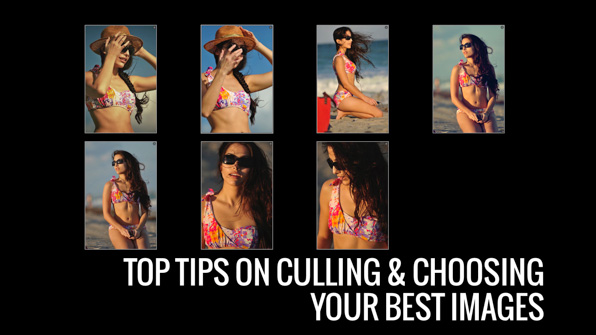
It doesn’t matter if you’re a complete photo neophyte, enthusiast, or a working pro photographer, learning to cull your photos and choose the best ones is critical in being successful. It will seem a tedious, and somewhat emotionally painful task. That being said, it’s still so important and something you need to do. If you shoot 1000 photos maybe 10 will be worth showing, while most of the remainder simply isn’t needed. Culling helps you declutter, and see the forest for the trees – the big picture. The big picture, is keeping and producing a spectacular body of work that’s a true reflection of your talent and brand.
If you flip through a magazine or a pro portfolio, you won’t see the same/very similar images over and over. The reason is that pros photographers and editors alike are a) strapped for space, and b) work endlessly towards quality over quantity and strive for high effectiveness. They’re going for the utter best image that is going to convey and achieve what they are trying to illustrate. This is the mindset to have.
Why Is It Important?
There could be scores written about the merits of culling and effective selection, but it helps to think of it from the perspective of the client, and as a business owner.
You should understand that when you’re chosen by a client, you’ve been hired not just for your technical ability to capture what you artistically envision, but also for your editing ability. Editing doesn’t simply mean retouching, but literally filtering – sorting the wheat from the chaff. If you show too many images, clients become overwhelmed and aren’t able to choose what they really love. Yet provide too little, and their lack of choice leaves a poor aftertaste and they may take only the bare minimum. Like everything else in life, there must be a balance struck.

Speaking of balance, I think it’s important to keep in mind that during this process you need to find a balance between what you like and what your client likes. If you go with solely what your client likes, or thinks they like, you will lose your sanity, joy, and part of your personal brand. However, if you go with only what you like you’ll lose clients. It’s still your vocation and you need to protect it and continue it even after this one job, but you need clients.
[REWIND: Understanding Retouching: Take Advice from a Make-up Artist]
Tips On Culling & Choosing Your Best Images
Think!…Then Shoot
It’s difficult to really stress the importance of preparation before a shoot, thinking about what you want to get out of the shoot to begin with. Shooting in film certainly helped force a bit more focus and preparation, but in digital we’re largely more experimental, which is okay, but also more frivolous, which is not. Think about what you are shooting, and why that image is really one you want. Sure lighting could strike in the heat of the moment, but don’t bank on it. This step alone will help reduce the amount of ‘waste.’ *I’m aware this is certainly easier for a seasoned pro who, through experience, has a good idea of what they’re going for and need.
Go Small, THEN Go Big!
Scale/zoom out of your collection of images down to a relatively small size, I prefer just slightly larger than thumbnail. Achieving this is easily done in programs like Lightroom. When you view your images at this size, details fall away, but larger issues become more obvious; like framing, angle, composition, dead space, and also it’s easier to spot similarities to photos next to each other. This is a huge step in the process, but its important, that once you’ve done this and gotten rid of the ones with blatant issues, it’s important to get big, really big.
Going large will take a photo you think is great, and show up issues that on a smaller frame you would miss. Some examples are slight motion blur of a key point, distracting clutter, or unflattering facial expressions. There really is no substitute for seeing your images large. I actually found getting a larger computer monitor invaluable just because it showed up flaws I would never have easily seen otherwise.

Do It Quickly
When you’re in your collection viewing the small size, it’s really helpful to quickly scan your images. Go through at speed and anything blatant that’s there will stand out, and makes it easier to just stomp that image out of the process. This is even a good idea to do after you think you’ve found the chosen few you’d like to present.
I’ve found Lightroom’s ability to highlight images by making a selection, and pressing the ‘L’ key once, then twice, removes so much screen clutter it also helps to focus my eyes on the images, and often gives that little nudge when a bit stuck. For those who don’t know it, try it out and it’ll look something like this:


Another benefit is if you go really fast, and I mean dizzyingly so for the first run, the next time round you can function more quickly and it won’t seem difficult. It’s almost like when you’re driving at 70mph on the highway, and then come off onto a residential road and 40 just seems painfully slow, because your brain is still processing information at speed.
Final Tips & Thoughts
It’s safe to say this process becomes more fluid with time, and the more you shoot. Its merits also become more apparent. On your way to becoming better at this, here are just a few little things to look for in photos as you’re scanning, especially in the thumbnail view.
- Distracting bits of clutter – from unwanted people, to stains, structures, or even colors and textures (breaks in a consistency of pattern is a big one). Anything that takes away from the focal point of the photo.
- Frame issues – keep an eye out to make sure the frame of your photos isn’t cutting someone off at strange spots like joints, and also in case there are things coming in the frame you don’t want, like a branch, or a light, or gear.
- Odd expressions and things coming out of people’s bodies/heads – This one you may need to get a larger view for, but it happens all the time. From branches, to something in the far off background that in the photo can look like it’s growing out of someone’s arm or head. (This happened to me recently with a weird cloud formation)
- Empty space – while often a useful composition tool, poor execution can ruin a photo. A quick glance is usually all you’ll need to spot this one.
I know this is a tough process. Permanently deleting photos always makes me cringe. I usually end up being poor at it and keeping most, but when it comes time to display them, I’m absolutely ruthless. Sometimes, I’ll also step away for 30 min or so, and come back a bit refreshed and more objective.
I’ve found Lightroom to be the best all round program for mass display, selection, and organizing my photos, and the Compare and Survey view get a lot of use. I do understand LR can be a little slow at times if you’re running a less powerful computer, and if that’s the case, I would suggest taking a look at Photo Mechanic, though I think as an all rounder, LR is in a different class. We offer loads of free Lightroom tutorials to help you work and process better and more efficiently, and our Lightroom products are about the most comprehensive guides you’ll find. If you want to become finely tuned and efficient with your LR usage, and thus your editing, check out our Lightroom Workshop Collection that trains you from the ground, all the way up to professional LR use.
Happy Culling.













